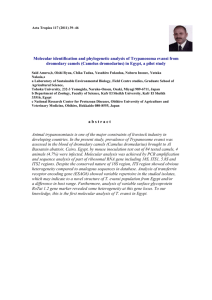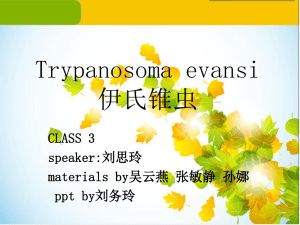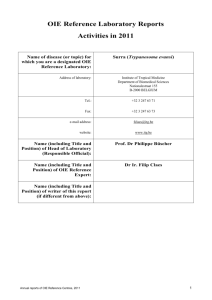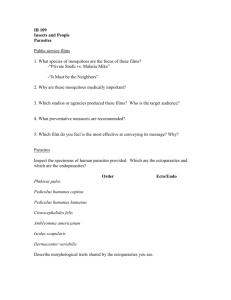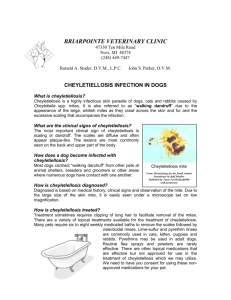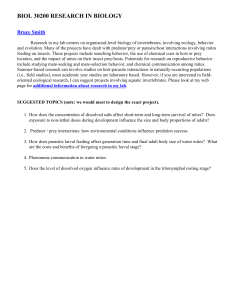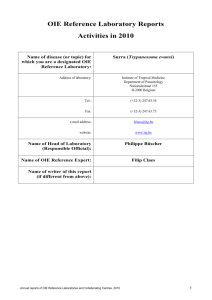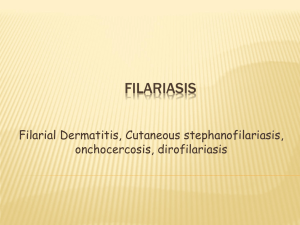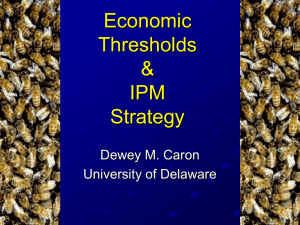Tetranychus evansi
advertisement
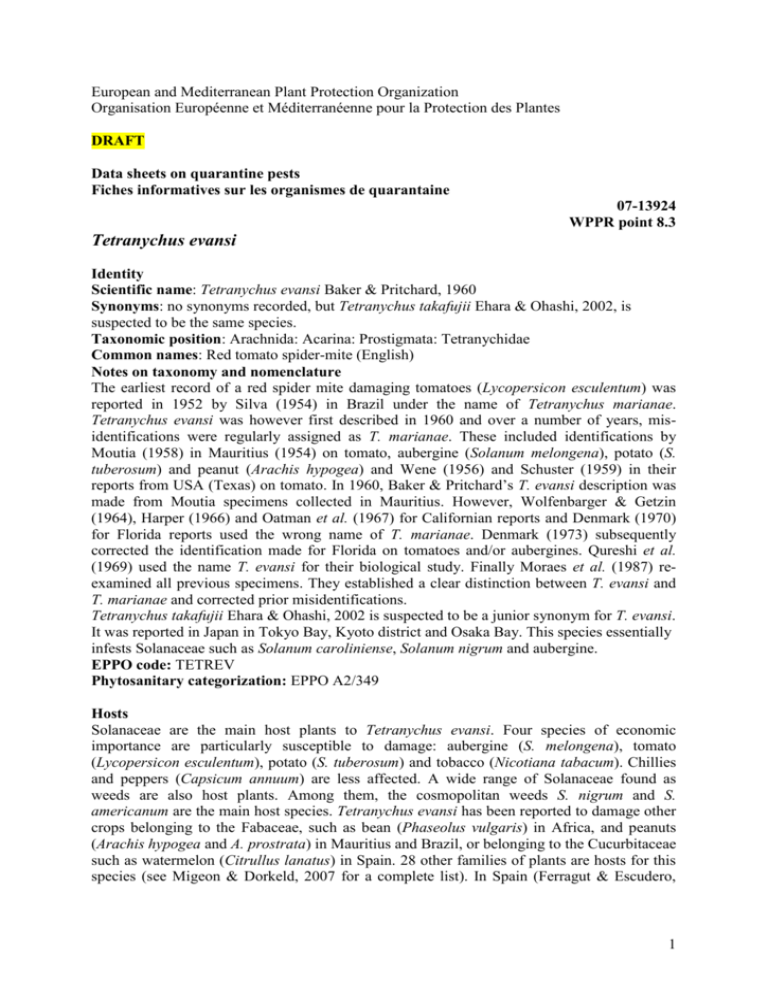
European and Mediterranean Plant Protection Organization Organisation Européenne et Méditerranéenne pour la Protection des Plantes DRAFT Data sheets on quarantine pests Fiches informatives sur les organismes de quarantaine 07-13924 WPPR point 8.3 Tetranychus evansi Identity Scientific name: Tetranychus evansi Baker & Pritchard, 1960 Synonyms: no synonyms recorded, but Tetranychus takafujii Ehara & Ohashi, 2002, is suspected to be the same species. Taxonomic position: Arachnida: Acarina: Prostigmata: Tetranychidae Common names: Red tomato spider-mite (English) Notes on taxonomy and nomenclature The earliest record of a red spider mite damaging tomatoes (Lycopersicon esculentum) was reported in 1952 by Silva (1954) in Brazil under the name of Tetranychus marianae. Tetranychus evansi was however first described in 1960 and over a number of years, misidentifications were regularly assigned as T. marianae. These included identifications by Moutia (1958) in Mauritius (1954) on tomato, aubergine (Solanum melongena), potato (S. tuberosum) and peanut (Arachis hypogea) and Wene (1956) and Schuster (1959) in their reports from USA (Texas) on tomato. In 1960, Baker & Pritchard’s T. evansi description was made from Moutia specimens collected in Mauritius. However, Wolfenbarger & Getzin (1964), Harper (1966) and Oatman et al. (1967) for Californian reports and Denmark (1970) for Florida reports used the wrong name of T. marianae. Denmark (1973) subsequently corrected the identification made for Florida on tomatoes and/or aubergines. Qureshi et al. (1969) used the name T. evansi for their biological study. Finally Moraes et al. (1987) reexamined all previous specimens. They established a clear distinction between T. evansi and T. marianae and corrected prior misidentifications. Tetranychus takafujii Ehara & Ohashi, 2002 is suspected to be a junior synonym for T. evansi. It was reported in Japan in Tokyo Bay, Kyoto district and Osaka Bay. This species essentially infests Solanaceae such as Solanum caroliniense, Solanum nigrum and aubergine. EPPO code: TETREV Phytosanitary categorization: EPPO A2/349 Hosts Solanaceae are the main host plants to Tetranychus evansi. Four species of economic importance are particularly susceptible to damage: aubergine (S. melongena), tomato (Lycopersicon esculentum), potato (S. tuberosum) and tobacco (Nicotiana tabacum). Chillies and peppers (Capsicum annuum) are less affected. A wide range of Solanaceae found as weeds are also host plants. Among them, the cosmopolitan weeds S. nigrum and S. americanum are the main host species. Tetranychus evansi has been reported to damage other crops belonging to the Fabaceae, such as bean (Phaseolus vulgaris) in Africa, and peanuts (Arachis hypogea and A. prostrata) in Mauritius and Brazil, or belonging to the Cucurbitaceae such as watermelon (Citrullus lanatus) in Spain. 28 other families of plants are hosts for this species (see Migeon & Dorkeld, 2007 for a complete list). In Spain (Ferragut & Escudero, 1 1999), very high densities of spider mites have been recorded on Sonchus spp. and Conyzia spp. (Asteraceae), Convolvulus arvensis (Convolvulaceae), Parietaria officinalis (Urticaceae). Geographical distribution This species is thought to originate from South-America and has been introduced to other parts of the world. Because the pest can easily be confused with other Tetranychus species, the distribution patterns of this pest worldwide are uncertain, e.g. T. evansi could be present on crops but considered to be another Tetranychus species, or it could be present on non-crop plants and therefore overlooked. See Migeon & Dorkeld (2007) for map and country list. EPPO region: France (Pyrénées-Orientales, Alpes Maritimes, Var), Greece (Tsagarakou, 2007), Israel, Italy (Liguria), Jordan (Palevsky, pers. com. 2007), Portugal (from Algarve to Lisbon including Madeira), Spain (Canary Islands, Balearic Islands, along the Mediterranean coast, Atlantic coast of Andalusia). Asia: Israel (EPPO, 2006), Jordan (Palevsky, pers. com. 2007), Taiwan (including Kinmen and Lienchang Islands). If T. takafujii is shown to be a synonym of T. evansi, then the pest also occurs in Japan. Africa: Democratic Republic of Congo, Congo, Gambia, Kenya, Malawi, Mauritius (including Rodrigues island), Morocco, Mozambique, Namibia, Niger (Migeon, pers. com. 2007), Reunion Island, Senegal, Seychelles, Somalia, South Africa, Tunisia, Zambia, Zimbabwe. Detection of T. evansi on consignments of plant products from Gambia, suggests that T. evansi may also be present in Gambia (A Macleod, pers. com. 2007). North America: USA (Arizona, California, Florida, Texas, Hawaii). Central America and Caribbean: Puerto Rico, Virgin Islands South America: Brazil, Argentina Oceania: Hawaii (USA). Biology Arrhenotokous parthenogenesis is the rule for Tetranychid mites. Unfertilised eggs develop into haploid males while diploid females are produced biparentally from fertilized eggs. The sex-ratio is about 70% females. Tetranychus evansi reproduction is continuous throughout the year. No diapause has been observed even in the coldest parts of its distribution area nor for T. takafujii in Tokyo Bay (Ohashi et al., 2003). This could limit the distribution to areas with moderately cold winters. Qureshi et al. (1969), Moraes & McMurtry (1987) and Bonato (1999) have studied the lifehistory of the mite. The theoretical minimal growing temperature varies from 10.3°C to 13.7°C depending on authors and stages. The optimal temperature is 34°C and the maximal 38°C. The duration of development from egg to adult ranges from 46 days at 15°C to 8-13 days at 25°C and 6 days at 35°C. The number of eggs laid by females varies from 80 with extreme low and high temperatures to a range of 120-250, depending on the authors, for optimal temperatures. This mite has one of the highest rates of population increase among Tetranychus species (~0.4) which leads to heavily infested plants at the end of a favourable growing season. This phenomenon causes spectacular outbreaks and high mite populations 2 can kill host plants. Dispersal behaviour is associated with outbreaks, in which mites form large aggregates at the top of the infested plants and are blown with the wind. Detection and identification Symptoms Mites live on both sides of the leaf with a slight preference for the underside and for the vicinity of the veins. Feeding causes the leaves to become chlorotic. White to brown (depending of the plant species) spots caused by the mites salivary contents appear on both sides and may lead to the death of parenchym cells. Important webs are also produced. In high infestations the dense web can “mummify” the plant. In very heavy infestations, which are frequent, feeding and webbing cause the death of the plant (see figs 1 to 7). Morphology Descriptions of the mites are given by Silva (1954), Baker & Pritchard (1960), Jeppson et al. (1975) and Moraes et al. (1987). Eggs Almost circular (average size 120 µm). Newly laid, they are bright and hyaline but later become rust red prior to hatching. Larval and nymphal stages In Tetranychidae, three different mobile immature stages, followed by immobile stages are observed. Pre-adult stages are greenish yellow. The first stage, larva, bears only 3 pairs of shorts legs (size: 150 µm). It is followed by the protochrysalis before moulting. The protonymph bears 4 pairs of legs and is followed by the immobile deutochrysalis. The deutonymph (size: 310 µm) looks like a small adult with shorter legs. Adult Both sexes vary in colour, depending on age and host plants. Older individuals are darker. The basis of the coloration is orange but it can vary from light orange to dark red or even brown. Unlike T. urticae (=cinnabarinus), the two black spot are lacking. Females are a broad oval shape with an average size of 450 x 335 µm. In comparison with many other species of the genus Tetranychus, the legs are longer. The body setae are not a criterion to distinguish from other species. Nevertheless, the setae borne by the first pair of legs can be useful: the female of T. evansi have the proximal (to the body) duplex setae (a very long and a short setae paired) in line with the four other setae. Males are much smaller than females and elongate triangular in shape with an average size of 350 x 210 µm. The lateral shape of the male aedeagous is one of the most useful criterion for the specific diagnostic. The aedeagous is shoe shaped with a posterior knob forming a wide angle with the axis of the shape; and with the anterior angulation much smaller than the posterior, which is acute and somewhat deflexed (Moraes et al., 1987) Identification requires examination of cleared, laterally mounted males and dorsally mounted female specimens by transmitted phase contrast light microscopy. Diagnostic descriptions are given by Moraes et al. (1987). Pathway for movement Local movement is mainly linked to wind currents. In international trade, T. evansi may be carried on Solanaceous plants for planting (except tubers and seeds) and this is the hypothesis 3 used to explain the introduction of the pest e.g. in Africa. The mites are less likely to infest fruits, these only present a risk where peduncles are present (aubergines, vine tomatoes, fresh beans, and to a lesser degree, chillies and peppers). Pest significance Economic impact Tetranychus evansi is regarded as an important pest of tomato and other solanaceous crops. In East and South Africa it has been considered the most important dry season pest of tomatoes (Knapp, 2002) since it was first recorded in 1979 and yield losses are noted. In Western Africa, it damages tomatoes and aubergines (Duverney & Ngueye-Ndiaye, 2005). Tetranychus evansi is one of four species of red spider mites causing damage in vegetable crops in eastern Spain (Escudero and Ferragut, 2005), although there is no specific data on economic impact caused by T. evansi alone (Ferragut, pers. com. 2007). In Spain, damage has only been recorded in outdoor crops such as aubergine, potato and tomato (Ferragut, pers com. 2007) the same situation occurs in Israel on aubergine and potato. The most severe damage in Israel occurs on aubergine (Palevsky pers. com. 2007). Few outbreaks are recorded under protected conditions, even in areas where the pest is present outdoors on weeds. In some situations, the use of acaricides may be the explanation as to why T. evansi does not establish in protected conditions. In infested EPPO countries T. evansi can kill Solanum nigrum but such damage has not been noted on other host plants. An outbreak in organic farming production unit was detected in southern France on tomato in protected cultivation in October 2007 (Migeon, pers. com. 2007). This illustrates the potential of the pest to cause damage in protected organic farming cultivation. Control Acaricides are commonly used against T. evansi and other spider mites on Solanaceous crops. Mites populations have developed resistance, in particular in Zimbabwe during the 1980s but current use of non organo-phosphorous acaricides is effective at controlling populations although it does not allow integrated crop protection or organic production. The widely used phytoseiid mites, Neoseiulus californicus and Phytoseiulus persimilis show a poor ability to suppress T. evansi populations on commercial crops (Escudero & Ferragut 2005). Research has been conducted to identify natural enemies associated with T. evansi in Southern America (Rosa et al. (2005); Furtado et al. (2006); Fiaboe et al. (2007)). A potential natural enemy: Phytoseiulus longipes has been identified in Brazil: (Ferrero et al., 2007). Phytosanitary risk Tetranychus evansi is a risk for tomato, aubergine and potato grown outdoors in the Mediterranean part of the region and for tomato and aubergine grown in protected cultivation in whole EPPO countries. Phytosanitary measures In preparation. Bibliography Baker, E. W. and A. E. Pritchard (1960). The tetranychoid mites of Africa. Hilgardia 29(11): 455-574. Ben-David, T., S. Melamed, U. Gerson and S. Morin (2007). ITS2 sequences as barcodes for identifying and analyzing spider mites (Acari: Tetranychidae). Experimental & Applied Acarology 41: 169-181. 4 Bonato, O. (1999). The effect of temperature on life history parameters of Tetranychus evansi (Acari: Tetranychidae). Experimental & Applied Acarology 23(1): 11-19. Castagnoli M, Nannelli R, Simoni S (2006) [Tetranychus evansi (Baker and Pritchard) (Acari: Tetranychidae), a new pest for Italy.]. Informatore Fitopatologico no. 5, 50-52 (in Italian). Denmark, H. A. (1970). The mariana mite, Tetranychus marianae McGregor, in Florida (Tetranychidae: Acarina), Florida Bureau of Entomology: 1. Denmark, H. A. (1973). Tetranychus evansi Baker and Pritchard in Florida. (Acarina: Tetranychidae), Florida Department of Agriculture. Division of Plant Industry: 1. Duverney, C. and A. Ngueye-Ndiaye (2005). Essais préliminaires pour limiter les dégâts de Tetranychidae sur les cultures maraîchères dans le Sine-Saloum (Sénégal). Deuxième colloque international sur les acariens des cultures, Montpellier. Ehara, S. and K. Ohashi (2002). A new species of Tetranychus (Acari: Tetranychidae) from the Kinki District, Japan. Acta Arachnologica 51(1): 19-22. Escudero, L. A. and F. Ferragut (2005). Life-history of predatory mites Neoseiulus californicus and Phytoseiulus persimilis (Acari: Phytoseiidae) on four spider mite species as prey, with special reference to Tetranychus evansi (Acari: Tetranychidae). Biological Control 32(3): 378-384. Ferragut, F. and L. A. Escudero (1999). Tetranychus evansi Baker & Pritchard (Acari, Tetranychidae),[a new red spider mite in Spanish horticultural production]. Boletin de Sanidad Vegetal, Plagas 25(2): 157-164. Ferreira, M. A. and M. M. Carmona (1995). Acarofauna do tomateiro em Portugal. Avances en Entomologia Ibérica, Museo Nacional Ciencias Naturales y Universidad de Madrid. Ferrero M, de Moraes GJ, Kreiter S, Tixier MS, Knapp M (2007) Experimental & Applied Acarology 41: 45-53. Fiaboe, K. K. M., M. G. C. Gondim, Jr., G. J. d. Moraes, C. K. P. O. Ogol and M. Knapp (2007). Surveys for natural enemies of the tomato red spider mite Tetranychus evansi (Acari: Tetranychidae) in northeastern and southeastern Brazil. Zootaxa 1395: 33-58. Furtado, I. P., G. J. d. Moraes, S. Kreiter and M. Knapp (2006). Search for effective natural ennemies of Tetranychus evansi in south and southeast Brazil. Experimental & Applied Acarology 40(3-4): 157-174. Harper, R. W. (1966). Bureau of entomology: new pest finds. California Department of Agriculture Bulletin 55(2): 92-93. Jeppson, L. R., H. H. Keifer and E. W. Baker (1975). Mites injurious to economic plants. Berkeley, University of California Press. Knapp, M. (2002). Important mite crop pest in Africa. XI International Congress of Acarology, Merida, Mexico. Migeon, A. and F. Dorkeld (2007) Spider mites web. http://www.montpellier.inra.fr/CBGP/spmweb. Moraes, G. J. d. and J. A. McMurtry (1987). Effect of temperature and sperm supply on the reproductive potential of Tetranychus evansi (Acari: Tetranychidae). Experimental & Applied Acarology 3(2): 95-107. Moraes, G. J. d., J. A. McMurtry and E. W. Baker (1987). Redescription and distribution of the spider mites Tetranychus evansi and T. marianae. Acarologia 28(4): 333-343. Moutia, L. A. (1958). Contribution to the study of some phytophagous Acarina and their predators in Mauritius. Bulletin of Entomological Research 49: 59-75. 5 Ohashi, K, Y. Kotsubo and A. Takafuji (2003). Distribution and overwintering ecology of Tetranychus takafujii (Acari: Tetranychidae), a species found from Kinki district, Japan. Journal of the Acarological Society of Japan 12(2): 107-113. Oatman, E. R., C. A. Fleschner and J. A. McMurtry (1967). New, highly destructive spider mite present in Southern California. Journal of Economic Entomology 60(2): 477-480. Qureshi, S. A., E. R. Oatman and C. A. Fleschner (1969). Biology of the spider mite, Tetranychus evansi. Annals of the Entomological Society of America 62(4): 898-903. Rosa, A. A., M. G. C. Gondim, Jr., K. K. M. Fiaboe, G. J. d. Moraes and M. Knapp (2005). Predatory mites associated with Tetranychus evansi Baker & Pritchard (Acari: Tetranychidae) on native solanaceous plants of coastal Pernambuco State, Brazil. Neotropical Entomology 34(4): 689-692. Schuster, M. F. (1959). Chemical control of Tetranychus marianae McG. on tomatoes in the lower Rio Grande Valley. Journal of Economic Entomology 52(4): 763-764. Silva, P. (1954). [A new acari harmful to tomato in Bahia]. Boletim do Instituto Biologica da Bahia 1(1): 1-20.(in Portugese) Wene, G. P. (1956). Tetranychus marianae McG., a new pest of tomatoes. Journal of Economic Entomology 49(5): 712. Wolfenbarger, D. A. and L. W. Getzin (1964). Insecticides and surfactant-insecticide combinations for control of the mite Tetranychus marianae McG., on tomatoes and eggplant. Florida Entomologist 42(2): 123-128. 6 Fig Damages of T. evansi in tomato protected cultivation (courtesy A. Migeon) 7
